SKODA FABIA 2005 1.G / 6Y Owner's Manual
Manufacturer: SKODA, Model Year: 2005, Model line: FABIA, Model: SKODA FABIA 2005 1.G / 6YPages: 260
Page 141 of 260
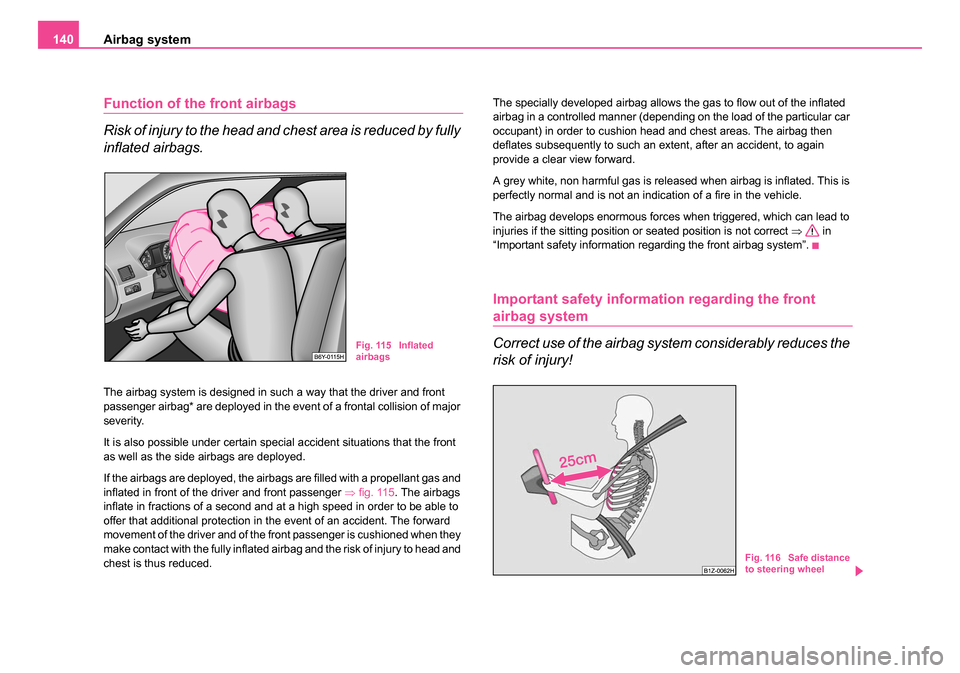
Airbag system
140
Function of the front airbags
Risk of injury to the head and chest area is reduced by fully
inflated airbags.
The airbag system is designed in such a way that the driver and front
passenger airbag* are deployed in the event of a frontal collision of major
severity.
It is also possible under certain special accident situations that the front
as well as the side airbags are deployed.
If the airbags are deployed, the airbags are filled with a propellant gas and
inflated in front of the driver and front passenger ⇒fig. 115 . The airbags
inflate in fractions of a second and at a high speed in order to be able to
offer that additional protection in the event of an accident. The forward
movement of the driver and of the front passenger is cushioned when they
make contact with the fully inflated airbag and the risk of injury to head and
chest is thus reduced. The specially developed airbag allows the gas to flow out of the inflated
airbag in a controlled manner (depending on the load of the particular car
occupant) in order to cushion head and chest areas. The airbag then
deflates subsequently to such an extent, after an accident, to again
provide a clear view forward.
A grey white, non harmful gas is released when airbag is inflated. This is
perfectly normal and is not an indication of a fire in the vehicle.
The airbag develops enormous forces when triggered, which can lead to
injuries if the sitting position or seated position is not correct
⇒ in
“Important safety information regarding the front airbag system”.
Important safety informat ion regarding the front
airbag system
Correct use of the airbag system considerably reduces the
risk of injury!
Fig. 115 Inflated
airbags
Fig. 116 Safe distance
to steering wheel
sqc.1.book Seite 140 Mittwoch, 13. April 2005 1:09 13
Page 142 of 260

Airbag system141
Using the systemSafetyDriving TipsGeneral MaintenanceBreakdown assist-
anceTechnical DataFabia Praktik
WARNING
•Never transport children on the front seat of a vehicle without
using a proper restraint system. If airbags are deployed in the event
of an accident, the child might suffer severe or even fatal injuries!
•For the driver and front passenger it is important to maintain a
distance of at least 25 cm from the steering wheel or dash panel
⇒ page 140, fig. 116 . Not maintaining this minimum distance will
mean that the airbag system will not be able to properly protect you
- hazard! The front seats and the head restraints must always also
be correctly adjusted to match the body size of the occupant.
•It is essential to always switch off ⇒page 144, “Deactivating an
airbag” the front passenger airbag when attaching a child safety
seat on the front passenger seat where the child is seated with its
back facing in direction of travel (in some countries also when the
child is facing the direction of travel). If this is not done, there is a
risk of the child suffering severe or even fatal injuries if the front
passenger airbag is deployed. In certain countries national legal
provisions also require that the side passenger airbags be deacti-
vated. When transporting a child on the front passenger seat,
please comply with the appropriate national regulations regarding
the use of child safety seats.
•There must not by any further persons, animals or objects posi-
tioned between the front seated occupants and the deployment
area of the airbag.
•The steering wheel and the surface of the airbag module in the
dash panel on the passenger side must not be stuck onto, covered
or modified in any other way. These parts should only be cleaned
with a dry cloth or a cloth moistened with water. No objects such as
cup holders, mobile phone mounts, etc. may be attached to the
covers of the airbag modules or be located within the immediate
area.
•No modifications of any kind may be made to parts of the airbag
system. Any work on the airbag system including removing and installing system components because of other repair work (e.g.
removing steering wheel) must only be carried out by a specialist
garage.
•Never carry out changes on the front bumper or on the body.
•Never place any objects on the surface of the front passenger
airbag in the dash panel.
Side airbags*
Description of side airbags
The side airbag increases protection of the passenger
concerned in the case of a side impact.
WARNING (continued)
Fig. 117 Driver seat:
Installation position of
airbag
sqc.1.book Seite 141 Mittwoch, 13. April 2005 1:09 13
Page 143 of 260
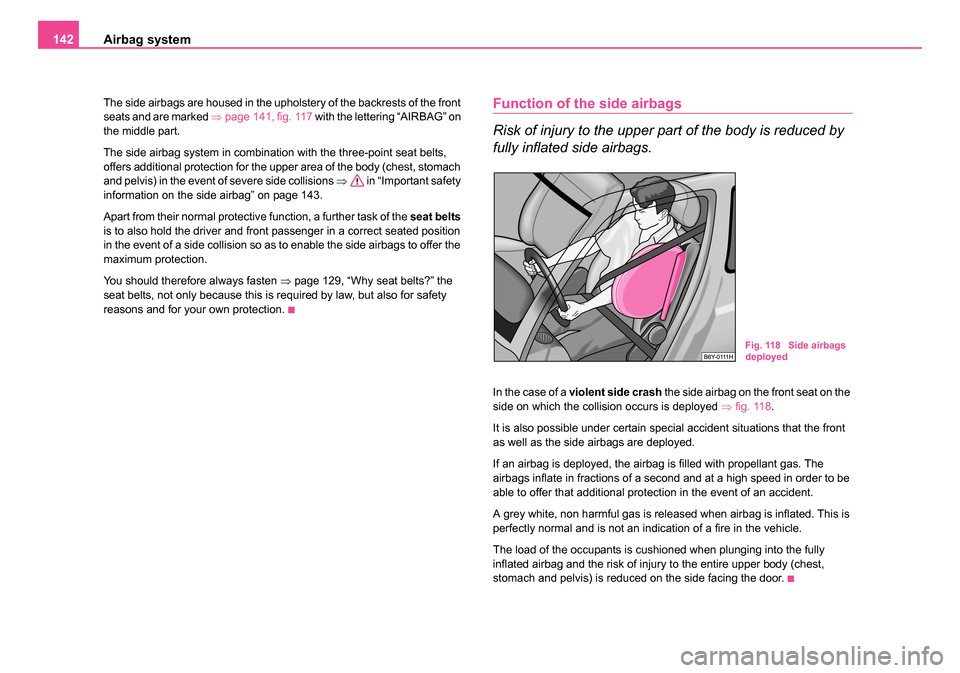
Airbag system
142
The side airbags are housed in the upholstery of the backrests of the front
seats and are marked ⇒ page 141, fig. 117 with the lettering “AIRBAG” on
the middle part.
The side airbag system in combination with the three-point seat belts,
offers additional protection for the upper area of the body (chest, stomach
and pelvis) in the event of severe side collisions ⇒ in “Important safety
information on the side airbag” on page 143.
Apart from their normal protective function, a further task of the seat belts
is to also hold the driver and front passenger in a correct seated position
in the event of a side collision so as to enable the side airbags to offer the
maximum protection.
You should therefore always fasten ⇒page 129, “Why seat belts?” the
seat belts, not only because this is required by law, but also for safety
reasons and for your own protection.Function of the side airbags
Risk of injury to the upper part of the body is reduced by
fully inflated side airbags.
In the case of a violent side crash the side airbag on the front seat on the
side on which the collision occurs is deployed ⇒ fig. 118.
It is also possible under certain special accident situations that the front
as well as the side airbags are deployed.
If an airbag is deployed, the airbag is filled with propellant gas. The
airbags inflate in fractions of a second and at a high speed in order to be
able to offer that additional protection in the event of an accident.
A grey white, non harmful gas is released when airbag is inflated. This is
perfectly normal and is not an indication of a fire in the vehicle.
The load of the occupants is cushioned when plunging into the fully
inflated airbag and the risk of injury to the entire upper body (chest,
stomach and pelvis) is reduced on the side facing the door.
Fig. 118 Side airbags
deployed
sqc.1.book Seite 142 Mittwoch, 13. April 2005 1:09 13
Page 144 of 260
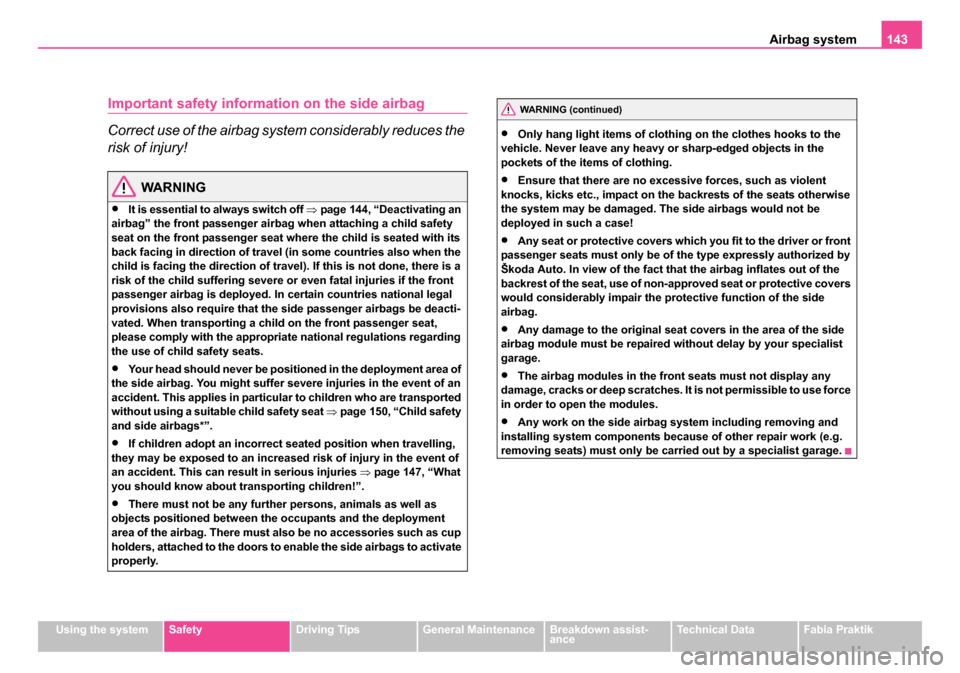
Airbag system143
Using the systemSafetyDriving TipsGeneral MaintenanceBreakdown assist-
anceTechnical DataFabia Praktik
Important safety informat ion on the side airbag
Correct use of the airbag system considerably reduces the
risk of injury!
WARNING
•It is essential to always switch off ⇒page 144, “Deactivating an
airbag” the front passenger airbag when attaching a child safety
seat on the front passenger seat where the child is seated with its
back facing in direction of travel (in some countries also when the
child is facing the direction of travel). If this is not done, there is a
risk of the child suffering severe or even fatal injuries if the front
passenger airbag is deployed. In certain countries national legal
provisions also require that the side passenger airbags be deacti-
vated. When transporting a child on the front passenger seat,
please comply with the appropriate national regulations regarding
the use of child safety seats.
•Your head should never be positioned in the deployment area of
the side airbag. You might suffer severe injuries in the event of an
accident. This applies in particular to children who are transported
without using a suitable child safety seat ⇒page 150, “Child safety
and side airbags*”.
•If children adopt an incorrect seated position when travelling,
they may be exposed to an increased risk of injury in the event of
an accident. This can result in serious injuries ⇒page 147, “What
you should know about transporting children!”.
•There must not be any further persons, animals as well as
objects positioned between the occupants and the deployment
area of the airbag. There must also be no accessories such as cup
holders, attached to the doors to enable the side airbags to activate
properly.
•Only hang light items of clothing on the clothes hooks to the
vehicle. Never leave any heavy or sharp-edged objects in the
pockets of the items of clothing.
•Ensure that there are no excessive forces, such as violent
knocks, kicks etc., impact on the backrests of the seats otherwise
the system may be damaged. The side airbags would not be
deployed in such a case!
•Any seat or protective covers which you fit to the driver or front
passenger seats must only be of the type expressly authorized by
Škoda Auto. In view of the fact that the airbag inflates out of the
backrest of the seat, use of non-approved seat or protective covers
would considerably impair the protective function of the side
airbag.
•Any damage to the original seat covers in the area of the side
airbag module must be repaired without delay by your specialist
garage.
•The airbag modules in the front seats must not display any
damage, cracks or deep scratches. It is not permissible to use force
in order to open the modules.
•Any work on the side airbag system including removing and
installing system components because of other repair work (e.g.
removing seats) must only be carried out by a specialist garage.
WARNING (continued)
sqc.1.book Seite 143 Mittwoch, 13. April 2005 1:09 13
Page 145 of 260

Airbag system
144
Deactivating an airbag
Deactivating airbags
If any airbags have been deactivated, switch them on
again as soon as possible so that they are able to again
provide their proper protection.
There is the technical means installed within your vehicle to switch off the
front passenger airbag or side airbag (take out of commission).
This is why you should have the deactivation of the airbags carried out by
a specialist garage.
On vehicles equipped with the switch for deactivation of the airbags, you
can deactivate the front passenger airbag or passenger side airbag by
means of this switch ⇒page 145.
Deactivation of airbags is envisaged only for particular instances,
such as if:
•you must in exceptional cases use a child seat on the front
passenger seat where the child has its back to the direction of travel of the
vehicle (in some countries this must be in the direction of travel due to
other legal regulations applying) ⇒page 147, “Important safety informa-
tion on using child safety seats”,
•you are not able to maintain the distance of at least 25 cm between
middle of steering wheel and chest, despite the driver seat being correctly
adjusted,
•special attachments are required in the area of the steering wheel
because of a physical disability,
•you have installed other seats (e.g. orthopaedic seats without side
airbags). Monitoring the airbag system
The functionality of the airbag system is also monitored electronically,
when one airbag has been switched off
If the airbag was switched off using diagnostic equipment:
•The airbag indicator light in the instrument cluster lights up for about 3
seconds after switching on the ignition and then flashes after that for about
12 seconds.
Front passenger airbags switched off using the switch for front
passenger airbags* in stowage compartment on the front passenger
side:
•The airbag warning light comes on in the instrument cluster for about
3 seconds each time the ignition is switched on.
•Switching off airbags is indicated in the middle of the dash panel by the
lighting up of the indicator light ⇒ page 145, fig. 120 .
Note
Your Škoda dealer will be able to advise you whether national legislation
in your country allows airbags in your vehicle to be deactivated, and which
ones.
sqc.1.book Seite 144 Mittwoch, 13. April 2005 1:09 13
Page 146 of 260
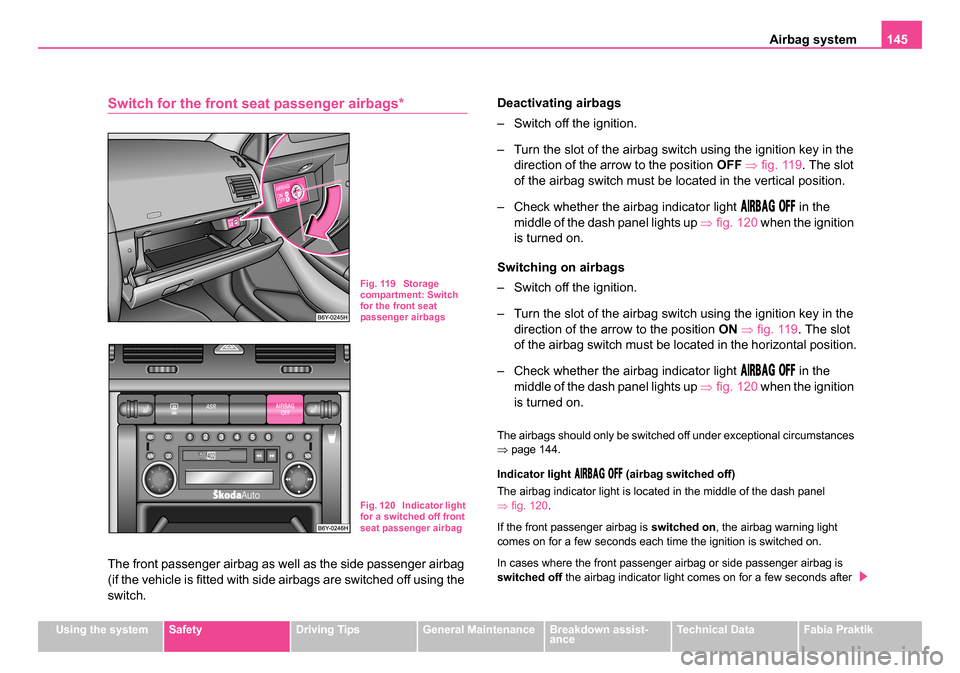
Airbag system145
Using the systemSafetyDriving TipsGeneral MaintenanceBreakdown assist-
anceTechnical DataFabia Praktik
Switch for the front seat passenger airbags*
The front passenger airbag as well as the side passenger airbag
(if the vehicle is fitted with side airbags are switched off using the
switch. Deactivating airbags
– Switch off the ignition.
– Turn the slot of the airbag switch using the ignition key in the
direction of the arrow to the position OFF ⇒ fig. 119 . The slot
of the airbag switch must be located in the vertical position.
– Check whether the airbag indicator light
in the
middle of the dash panel lights up ⇒fig. 120 when the ignition
is turned on.
Switching on airbags
– Switch off the ignition.
– Turn the slot of the airbag switch using the ignition key in the direction of the arrow to the position ON ⇒ fig. 119 . The slot
of the airbag switch must be located in the horizontal position.
– Check whether the airbag indicator light
in the
middle of the dash panel lights up ⇒fig. 120 when the ignition
is turned on.
The airbags should only be switched off under exceptional circumstances
⇒ page 144.
Indicator light
(airbag switched off)
The airbag indicator light is located in the middle of the dash panel
⇒ fig. 120 .
If the front passenger airbag is switched on, the airbag warning light
comes on for a few seconds each time the ignition is switched on.
In cases where the front passenger airbag or side passenger airbag is
switched off the airbag indicator light comes on for a few seconds after
Fig. 119 Storage
compartment: Switch
for the front seat
passenger airbags
Fig. 120 Indicator light
for a switched off front
seat passenger airbag
sqc.1.book Seite 145 Mittwoch, 13. April 2005 1:09 13
Page 147 of 260
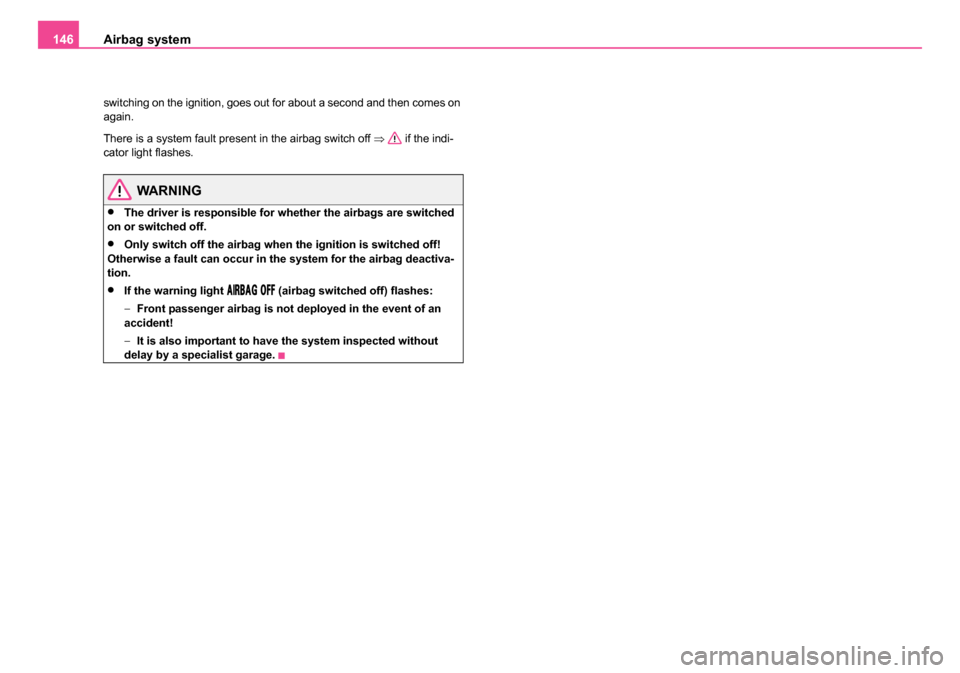
Airbag system
146
switching on the ignition, goes out for about a second and then comes on
again.
There is a system fault present in the airbag switch off ⇒ if the indi-
cator light flashes.
WARNING
•The driver is responsible for whether the airbags are switched
on or switched off.
•Only switch off the airbag when the ignition is switched off!
Otherwise a fault can occur in the system for the airbag deactiva-
tion.
•If the warning light (airbag switched off) flashes:
− Front passenger airbag is not deployed in the event of an
accident!
− It is also important to have the system inspected without
delay by a specialist garage.
sqc.1.book Seite 146 Mittwoch, 13. April 2005 1:09 13
Page 148 of 260
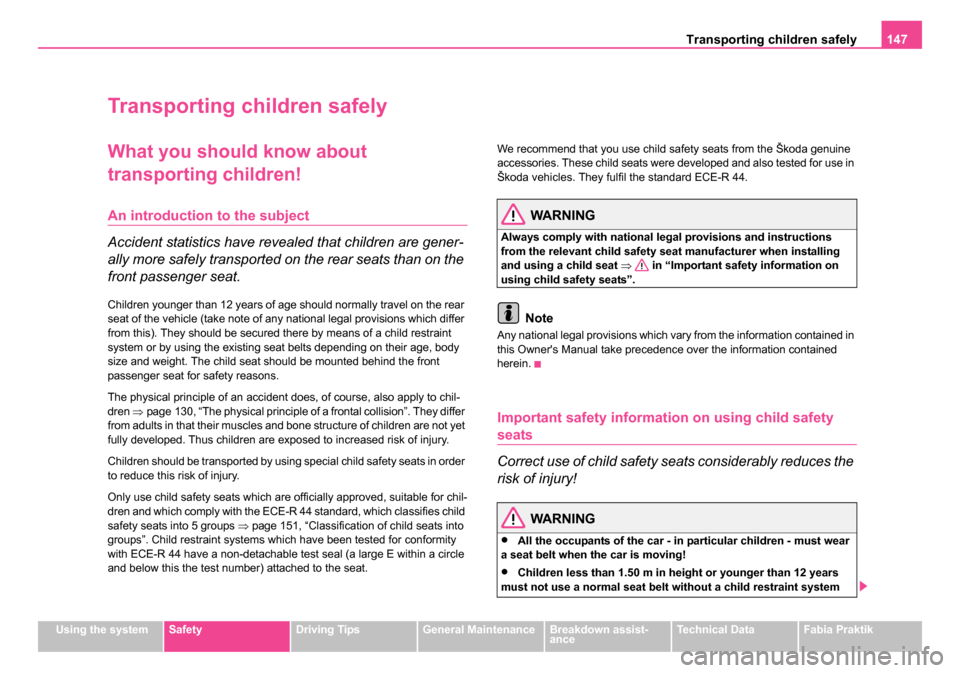
Transporting children safely 147
Using the systemSafetyDriving TipsGeneral MaintenanceBreakdown assist-
anceTechnical DataFabia Praktik
Transporting children safely
What you should know about
transporting children!
An introduction to the subject
Accident statistics have revealed that children are gener-
ally more safely transported on the rear seats than on the
front passenger seat.
Children younger than 12 years of age should normally travel on the rear
seat of the vehicle (take note of any national legal provisions which differ
from this). They should be secured there by means of a child restraint
system or by using the existing seat belts depending on their age, body
size and weight. The child seat should be mounted behind the front
passenger seat for safety reasons.
The physical principle of an accident does, of course, also apply to chil-
dren ⇒page 130, “The physical principle of a frontal collision”. They differ
from adults in that their muscles and bone structure of children are not yet
fully developed. Thus children are exposed to increased risk of injury.
Children should be transported by using special child safety seats in order
to reduce this risk of injury.
Only use child safety seats which are officially approved, suitable for chil-
dren and which comply with the ECE-R 44 standard, which classifies child
safety seats into 5 groups ⇒page 151, “Classification of child seats into
groups”. Child restraint systems which have been tested for conformity
with ECE-R 44 have a non-detachable test seal (a large E within a circle
and below this the test number) attached to the seat. We recommend that you use child safety seats from the Škoda genuine
accessories. These child seats were developed and also tested for use in
Škoda vehicles. They fulfil the standard ECE-R 44.
WARNING
Always comply with national lega
l provisions and instructions
from the relevant child safety seat manufacturer when installing
and using a child seat ⇒ in “Important safety information on
using child safety seats”.
Note
Any national legal provisions which vary from the information contained in
this Owner's Manual take precedence over the information contained
herein.
Important safety informat ion on using child safety
seats
Correct use of child safety seats considerably reduces the
risk of injury!
WARNING
•All the occupants of the car - in particular children - must wear
a seat belt when the car is moving!
•Children less than 1.50 m in height or younger than 12 years
must not use a normal seat belt without a child restraint system
sqc.1.book Seite 147 Mittwoch, 13. April 2005 1:09 13
Page 149 of 260
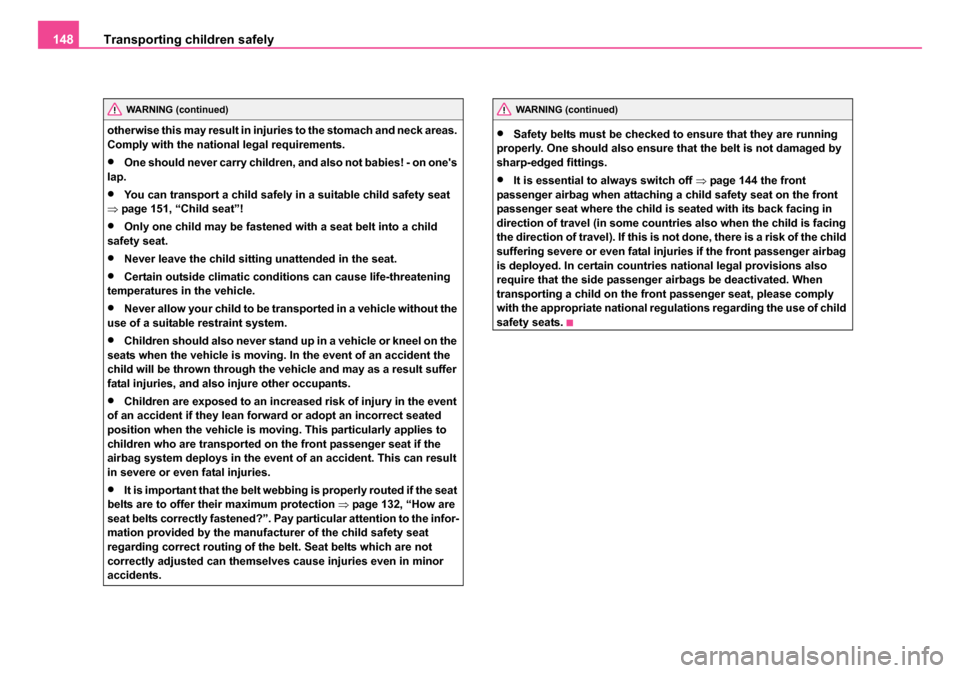
Transporting children safely
148
otherwise this may result in injuries to the stomach and neck areas.
Comply with the nation al legal requirements.
•One should never carry children, and also not babies! - on one's
lap.
•You can transport a child safely in a suitable child safety seat
⇒ page 151, “Child seat”!
•Only one child may be fastened with a seat belt into a child
safety seat.
•Never leave the child sitting unattended in the seat.
•Certain outside climatic conditions can cause life-threatening
temperatures in the vehicle.
•Never allow your child to be transported in a vehicle without the
use of a suitable restraint system.
•Children should also never stand up in a vehicle or kneel on the
seats when the vehicle is moving. In the event of an accident the
child will be thrown through the ve hicle and may as a result suffer
fatal injuries, and also injure other occupants.
•Children are exposed to an increased risk of injury in the event
of an accident if they lean forward or adopt an incorrect seated
position when the vehicle is movi ng. This particularly applies to
children who are transported on the front passenger seat if the
airbag system deploys in the event of an accident. This can result
in severe or even fatal injuries.
•It is important that the belt webbing is properly routed if the seat
belts are to offer their maximum protection ⇒page 132, “How are
seat belts correctly fastened?”. Pay particular attention to the infor-
mation provided by the manufacturer of the child safety seat
regarding correct routing of the belt. Seat belts which are not
correctly adjusted can themselves cause injuries even in minor
accidents.
•Safety belts must be checked to ensure that they are running
properly. One should also ensure that the belt is not damaged by
sharp-edged fittings.
•It is essential to always switch off ⇒page 144 the front
passenger airbag when attaching a child safety seat on the front
passenger seat where the child is seated with its back facing in
direction of travel (in some countri es also when the child is facing
the direction of travel). If this is not done, there is a risk of the child
suffering severe or even fatal injuries if the front passenger airbag
is deployed. In certain countries national legal provisions also
require that the side passenger airbags be deactivated. When
transporting a child on the front passenger seat, please comply
with the appropriate national regulations regarding the use of child
safety seats.
WARNING (continued)WARNING (continued)
sqc.1.book Seite 148 Mittwoch, 13. April 2005 1:09 13
Page 150 of 260
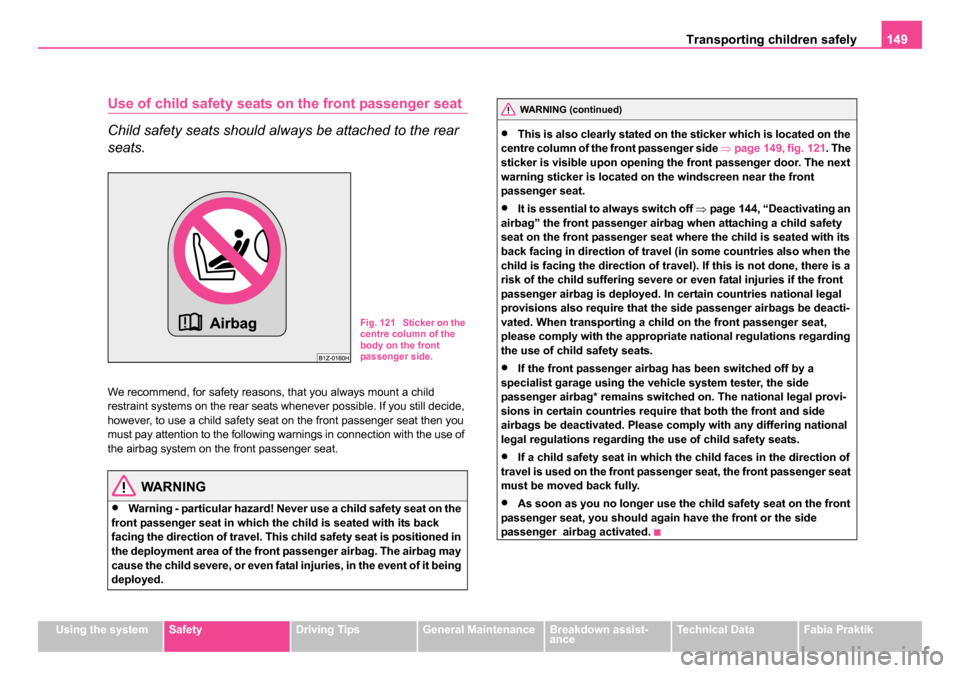
Transporting children safely 149
Using the systemSafetyDriving TipsGeneral MaintenanceBreakdown assist-
anceTechnical DataFabia Praktik
Use of child safety seats on the front passenger seat
Child safety seats should always be attached to the rear
seats.
We recommend, for safety reasons, that you always mount a child
restraint systems on the rear seats whenever possible. If you still decide,
however, to use a child safety seat on the front passenger seat then you
must pay attention to the following warnings in connection with the use of
the airbag system on the front passenger seat.
WARNING
•Warning - particular hazard! Never use a child safety seat on the
front passenger seat in which the child is seated with its back
facing the direction of travel. This child safety seat is positioned in
the deployment area of the front passenger airbag. The airbag may
cause the child severe, or even fatal injuries, in the event of it being
deployed.
•This is also clearly stated on the sticker which is located on the
centre column of the front passenger side ⇒page 149, fig. 121 . The
sticker is visible upon opening the front passenger door. The next
warning sticker is located on the windscreen near the front
passenger seat.
•It is essential to always switch off ⇒page 144, “Deactivating an
airbag” the front passenger airbag when attaching a child safety
seat on the front passenger seat where the child is seated with its
back facing in direction of travel (in some countries also when the
child is facing the direction of travel). If this is not done, there is a
risk of the child suffering severe or even fatal injuries if the front
passenger airbag is deployed. In certain countries national legal
provisions also require that the side passenger airbags be deacti-
vated. When transporting a child on the front passenger seat,
please comply with the appropriate national regulations regarding
the use of child safety seats.
•If the front passenger airbag has been switched off by a
specialist garage using the vehicle system tester, the side
passenger airbag* remains switched on. The national legal provi-
sions in certain countries require that both the front and side
airbags be deactivated. Please comply with any differing national
legal regulations regarding the use of child safety seats.
•If a child safety seat in which the child faces in the direction of
travel is used on the front passenger seat, the front passenger seat
must be moved back fully.
•As soon as you no longer use the child safety seat on the front
passenger seat, you should again have the front or the side
passenger airbag activated.
Fig. 121 Sticker on the
centre column of the
body on the front
passenger side.
WARNING (continued)
sqc.1.book Seite 149 Mittwoch, 13. April 2005 1:09 13